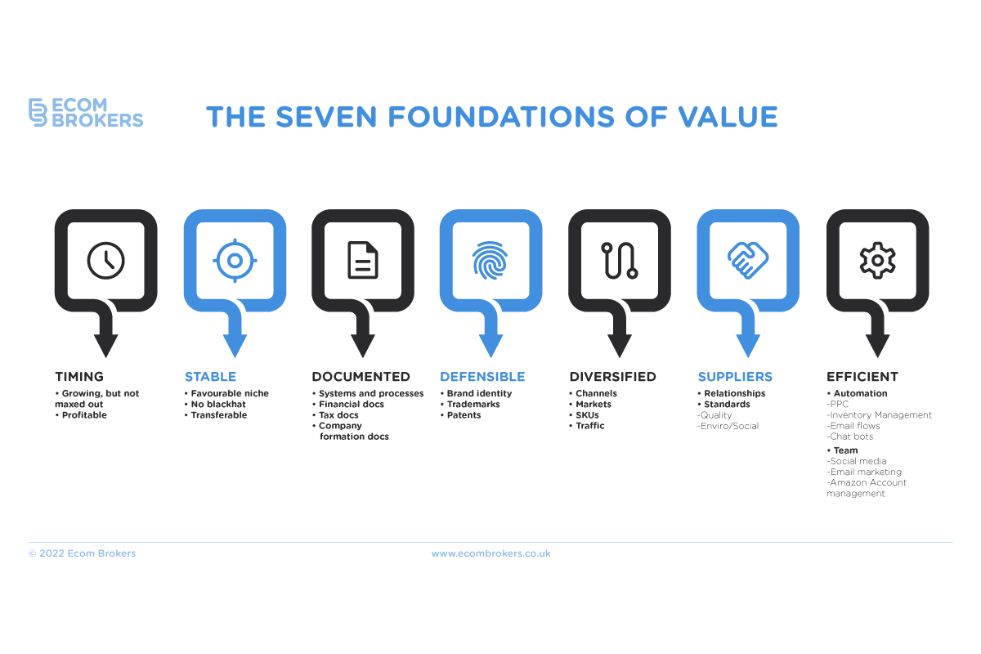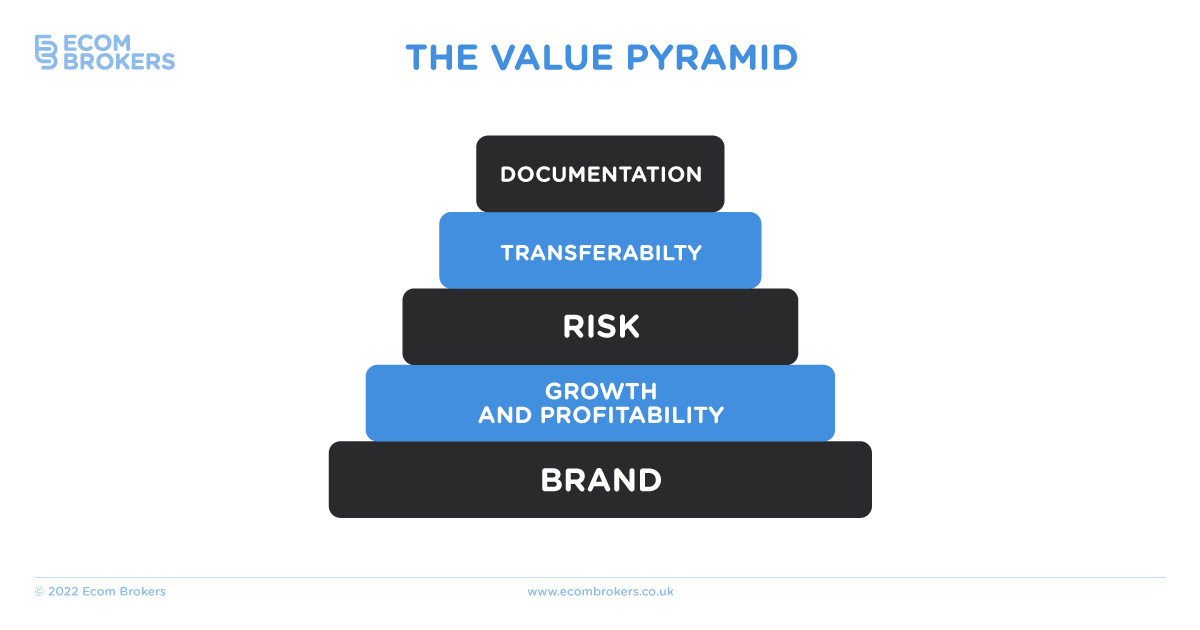
How To Sell Your Amazon Business For Maximum Profit
Creating, launching and working on an Amazon business is super exciting – but selling it can be just as exciting.
It can also be daunting, challenging and frustrating.
And it can leave us cursing the day we started an Amazon business in the first place.
If, however, you can sell your Amazon business for maximum profit, your entire venture will have been worth it, from inception to launch – to sale.
Of course, the nature of selling any business is complicated, and there’s no magic bullet that will allow you to finesse the process without putting in a few hours of hard work first.
But that’s totally cool – it’s what this article is here for. We’ll show you how to maximise your profit when selling your Amazon business so you can move on to your next venture with the funds you deserve.
But first …
When Should You Sell Your Amazon Business?
This is an important question that we need to get out of the way straight off the bat because there’s always a right time and a wrong time to sell any business, including an Amazon business.
Put it this way, if you sell your business at the wrong time, you will not be able to maximise your profit. You will lose out.
The good news is that it’s clear that Amazon businesses are a solid asset to sell. Indeed, according to the data, the number of new sellers on Amazon has been rising exponentially year-on-year since 2004. In 2020, there were over 1,000,000 new sellers alone.
Amazon is, of course, the biggest online retailer that consistently generates nearly $300,000,000,000 in revenue each year. In short, people are chomping at the bit to get a piece of the action – and they may turn to ready-made stores like yours so that they don’t have to start from the ground up.
When put like that, it seems obvious that it’s always a good time to sell an Amazon business. But that isn’t the case because you need to take a forensic look at your business and your situation (both personally and professionally) to make sure this is the right time to sell.
Consider this: If your business is young (less than a few years old), it’s the wrong time to sell.
Why?
Because it won’t be able to clearly demonstrate evidence of success, nor will it be able to show with any clarity growth potential. You simply won’t have the data. Instead, a much smarter thing to do in this instance is to keep working on your business for at least another year so that you can raise its revenue, its sales volume, and thus demonstrate real growth potential.
On the flip side, if your Amazon business is a few years old, now could be the right time to sell. You’ll certainly have the data to back you up one way or another, and if your business has clearly been successful for the last few years – well, that’s just another string in your bow.
But let’s take a look at other reasons why now may or may not be the right time to sell. For example, your personal circumstances. It’s often the case that a business is doing super well on Amazon, but that the seller has run into some rather tricky issues at home and thus needs to sell their business. They can no longer devote the same amount of time and effort into it anymore, and therefore it’s better if they just exit now.
For instance, maybe they’re looking to start a family, or maybe there’s been a death in the family. It could be anything.
Or, maybe a highly successful seller has simply decided they want to try something new professionally. Sure, they’ve enjoyed building their Amazon business over the years but now is the time to work on something else. Moreover, they need funds to start working on something else – and they can raise those funds by selling their Amazon business.
If any of the above circumstances apply to you, now might be a good time to sell your Amazon business. It’s just essential that you review your situation and make sure that now is either the right time to sell – or not. But if it feels right, and if you no longer wish to/or are able to commit to your Amazon business in the same way that you once did, then, yes, it might be time to move on.
With all that said, let’s now take a look at …
Priming Your Amazon Business For Maximum Profit
You might have a solid Amazon business on your hands that you’ve been succeeding with over the last few years. You’ve created it, launched it, built it and turned it into a revenue-generating brand that you’re really happy with.
But that doesn’t mean it’s ready to be sold for maximum profit. In order to sell it for maximum profit, it’s highly likely that there are still things you need to do in order to bump its value up. In this section of the article, we’re going to take a look at what those things are.
Diversify
There was an interesting observation that came out last year: Of the millions of sellers on Amazon, those that had 3,000+ listings performed way better than those with 1,500 or fewer listings.
Of course, 2020 was the year of the coronavirus, a year when supply chains were disrupted, people were forced to stay at home and online shopping habits changed. But the point is this: eCommerce sellers that diversify on Amazon have more chances of surviving hard times than those who don’t.
This also means that Amazon businesses which have diversified are more attractive to potential buyers.
However, diversifying your product offerings (which is essentially the same as saying that you’re diversifying your revenue supply) is just one part of the diversification puzzle. There is more you can do.
For instance, traffic sources. Where does most of your traffic come from at the moment? Does it mainly come from one source? If so, this is something you need to look at because, if that one source changes its algorithm or something else entirely unexpected occurs, you could lose a chunk of your traffic. And this would be very worrying to prospective buyers.
The more traffic sources you have, the more valuable your business will be.
What else can you diversify?
Well, there’s your marketing. If you’re not already taking advantage of affiliate marketing, this is something else you can consider. All you have to do is add your business to affiliate programs, and content creators will largely do the hard work for you. They’ll come along, create content based around your niche and products, and add links to their articles that are aimed at sending more traffic to your product pages. If your affiliate marketing campaign takes off, you can add more value to your store. Every little helps.
Also, circling going back to your product offerings. When you diversify your product offerings and add more listings, you can start promoting bundles (Amazon even has a section for this called Amazon Bundles) and cross-selling products. This sort of thing instantly raises the value of your business.
Secure More Online Reviews
Do shoppers trust online reviews?
You bet they do.
In fact, research has shown that 3 in 4 shoppers trust an online review just as much as a personal recommendation from a friend or family member.
Even better, product pages with tons of reviews achieve 3.5x better conversion rates than those with few (if any) reviews.
These are really good numbers that suggest the more Amazon reviews you have, the more sales you’ll make. Thus, the more attractive your Amazon store will be to potential buyers – and the more valuable it will be. More online reviews, then, are good for attracting more customers to make purchases, but they can also bump your product listings up in the Amazon SERPs.
But how do you go about securing more online reviews?
One thing you can do is to contact buyers and politely ask them if they’d be kind enough to leave you a review. Most buyers will definitely leave a review if asked because many of them don’t realise there’s a BIG difference where your store is concerned between a star rating and an actual written review.
So, you can reach out to your customers and ask them if they have the time to share a quick review of the product they recently bought from you.
A final tactic you could try is to offer more discounts and product giveaways as a way of making your customers feel so good about what they’ve bought that they’ll naturally feel inclined to leave a review. Now, this tactic won’t always work, but it can work more often than not. After all, when people feel good about our brand – when we spread goodwill – they will be more inclined to do a favour back for us. In this case, that return favour is leaving us a positive online review.
However, it’s also important to bear in mind the number of variables Amazon’s algorithm takes into consideration when assessing the importance of any product review. These include the age of the review, the reviewer’s profile (are they legit?), whether the review is an actual written review or just a rating, as well as whether the reviewer is verified or unverified.
Work With Trusted Suppliers
This one probably should have been further up the list because it’s so important. But here it is: The more secure your supply chain is, the more valuable your business is. This is true of any business and not just an Amazon business. A secure supply chain helps you to build trust among your customers because you’re able to a) have the products they want available when they want and b) you’re able to ship them and deliver to them on time.
A secure supply chain is also attractive to potential buyers and can help to raise the value of your overall business. Think about it – the more secure your supply chain is, the more it demonstrates that your flow and inventory is nice and stable. This means the potential buyer won’t have to dedicate time and resources to overhauling things. It’s already done for them!
So the advice here is to work on finding suppliers that come up with the goods time and time again. This also means narrowing down your supply chain so that it only includes a handful of suppliers. The more suppliers you have, the more headaches you’re likely to create for potential buyers who don’t really want the hassle of constantly negotiating new contracts.
Not just that, but when you work with too many suppliers, it’s highly likely that some of them will let you down. They’re not all as reliable as we’d like.
Outsource And Automate
We talk about outsourcing and automating a lot – and for a good reason.
Automation is the process of putting in place systems that allow your Amazon business to function without you having to commit too much of your own time and efforts. In other words, it can function smoothly and seamlessly without you having to be there. You’re still the owner, but you’re no longer needed on a day to day basis anymore.
How does this increase the value of your Amazon business?
It increases the value of your Amazon business because it means that any potential buyer who isn’t looking for a full time job (and no potential buyer is looking for a full time job) knows that they can come along, buy your business – and watch as the already well-oiled machine continues to function like a well-oiled machine.
All they really need to do is make tweaks here and there if they wish. They don’t have to make major, sweeping changes, and they don’t need to involve themselves in the business 24/7.
So what aspects of your Amazon business should you automate?
Well, pretty much everything! To help you automate, keep in mind two things:
- Technology
- Outsourcing
For example, you can use bookkeeping software and inventory management tools to help you automate your finances and your inventory. You can also use PPC management tools to help your store rank higher.
When it comes to outsourcing, meanwhile, you can work with copywriters to write awesome product listings and photographers to create outstanding photographs of your products.
Automating your inventory management is especially important because it will ensure you don’t miss out on potential sales while at the same time keeping your customers happy. Whenever your inventory is running low, you’ll be automatically alerted. Inventory management tools also help you to optimize your pricing. All of these things are really important when it comes to maximising your store’s value – and thus the profit you make when it comes time to sell.
Build A Brand Around Your Amazon Store
If you haven’t already built a brand around your Amazon store, we won’t lie to you – this is something that’s going to take quite a bit of time. But by building a brand around your online store, you’ll be able to maximise its value.
How so?
A few reasons.
A business that relies solely on Amazon (or any third party) is at the mercy of that third party. If Amazon decides to kick you off for any reason or severely restrict you, you’re as good as finished. It’s over. And this is because you literally don’t exist anywhere else.
When you’ve built a brand around your Amazon business, on the other hand, you’ve got a presence outside Amazon. You’ve got a website, social media profiles and a reputation. If something goes wrong with Amazon, you can still survive.
Moreover, you’re no longer just another faceless, brand-less entity on Amazon. Instead, you’re a proper, unique brand that customers recognise and may become loyal to.
Creating a brand for your Amazon business may take some time, but it is doable. Here are some things you may need to do:
- Launch a website
- Give your store a unique, original name
- Create a mailing list
Selling Your Amazon Business (For Maximum Profit)
So far, we’ve looked at how you can bump up the value of your Amazon business so that you sell it for as much profit as you can. But there’s more to extracting as much profit out of your business than simply preparing it for sale – you also need to actually be able to finesse the sales process.
This is where a number of first-time sellers fall down. While they are fine entrepreneurs who have successfully created, launched and scaled up an Amazon store, they’re a bit wet behind the ears when it comes to actually selling an online store. As a result, they don’t get the profit they deserve for it.
You’ve got four options open to you when it comes time to sell:
- Marketplace
- Auction
- DIY
- Hire a broker
Let’s take a look at each option one by one.
Marketplace
With a marketplace sale, you’ll be heavily involved in the sale. You’ll be vetting any potential buyers, signing NDA agreements, fielding questions and taking care of the whole negotiation process. It’s a lot of work, and we don’t recommend it for first-time business sellers.
One of the reasons we don’t recommend it is because marketplaces are crowded with competitors. This means you have to work extra hard to maximize your profit – and this can be very tricky to do. If you’re busy and aren’t sure of yourself, you may find that you don’t get the sale you wanted.
Auction
There are auction websites where you can list your Amazon business. Fees are quite high though (as much as 15% if the auction site manages to sell your business), considering that you have to do most of the work yourself.
An auction sale kinda works a lot like a marketplace sale in that you’ll be responsible for putting the business up for sale and talking to the potential buyers. The downside is that auctions tend to attract more unseasoned buyers who are making their first purchase. As such, they’re more popular with Amazon businesses that have lower values in the first place. If you want to maximise your profit, we recommend swerving an auction sale.
On the flip side, auction sales are typically completed within one and four weeks, which can be considered fast.
Do It Yourself
Amazon sellers who believe they can handle the entire sales process without outside assistance continue to favor the DIY approach.
And here’s the thing: it is possible to navigate the whole process without any help. But will you maximise your profit in the meantime? Well, that’s the big question.
There are some good reasons to sell your Amazon business all by yourself. You’ll be in full control from start to end, and there’ll be way less fees involved. So long as you get the best deal, you’ll be happy with the fees.
On the other hand, because you’ll be doing everything yourself, this method is very, very time consuming and involving. It could take up to two years for you to finally negotiate a sale, and even then you might not get the price you wanted. If you’re in a hurry to sell, if now is the “right time to sell” because you want to move onto another venture, the DIY approach may not be the best one.
Then there’s the thorny issue of negotiating the sale with potential buyers. How good are your negotiating skills? Are they so good that you’ll get the deal you want and not the deal they want?
Worse still, you simply won’t have a network of potential buyers you can offer your business to. Instead, it may be a case of “first come, first serve” and you may be short-changed.
A Broker
Selling your Amazon business with a broker is by far the best option if you’ve never done it.
Why?
For one thing, a broker will do most of the hard work for you. They will help you market your company, create a prospectus, and promote it to their buyer network.
They will also draft the sales agreement and negotiate the sale itself. This means that you can largely take a back seat and wait for the final sale to come in. You don’t have to do much of anything.
Even better, a broker is the most qualified person to sell your business for maximum value. They are tried and tested professionals who have sold businesses like yours (worth over $20,000) to buyers worldwide. They know how to negotiate, avoid pitfalls, and know how to answer your questions.
Naturally, brokers won’t do all this for free. There are fees involved in the form of commission, and you might have to pay as much as 15% in fees. But for the amount of work that a broker puts in, as well as for the fact that they are highly likely to maximise your profit, they are always worth it.
Also, brokers are generally very good at minimising legal expenses, so you pay less than you would if you did it yourself.
A broker can sell a business in 2 months or less, whereas DIY can take up to 2 years.
Preparing To Sell
Whichever way you decide to sell your business, you will still need to prepare it for sale.
And this part is just as crucial to maximising your profit as any other part.
Sort Out Your Finances
One of the most important things you can do is clean up your finances. This is especially true if you’re selling the business yourself or selling with a broker.
It’s difficult to prepare a profit and loss statement if your finances aren’t in order. A profit and loss statement includes incoming and outgoing funds, gross profit and revenue, and SKUs.
It’s also a good idea to add one-off expenses to your profit and loss statement (such as add-backs), as these demonstrate to any potential buyers the type of expenses they won’t really need to run your business. For example, you might include a visit to a conference in Bali.
If you haven’t been keeping track of your finances and are getting a headache just reading this, don’t panic.
The best thing to do is hire a bookkeeper or accountant to help you organise your finances.
Sort Out Your Contracts
Most people are unaware that an Amazon business is about much more than just the owner. The owner is the face of the business, but high value eCommerce stores have lots of moving parts. You may be working with an in-house team or a team of freelancers.
Either way, it’s highly likely that there are contracts that need to be sorted out now so that you can prepare your business for sale and make the handover more seamless.
For instance, if you’ve been working with freelancers (for example, maybe copywriters and graphic designers), now is the time to talk to them and ask if they’d be up for working with a new buyer. If they say yes – fantastic. Getting them on board will save any potential buyer the hassle of hiring new workers.
Next, you’ll want to turn your attention to your suppliers. If you’ve got a few exclusive agreements in place at the moment, and therefore have a good relationship with your suppliers, you need to chat to them about what you’re planning to do so that you know whether or not the agreements will be in place once a sale is made.
Once again, if you can show any potential buyer that they’ll be taking over a business that already has strong, working relationships with trusted buyers, you can make your business more attractive and thus get a better deal.
Exclusive agreements are always beneficial if you can sign them with your suppliers. They’re not always honoured, but they make a potential buyer feel much better about your business because – among other things – they safeguard them from the competition.
On the other hand, if it isn’t possible to get exclusivity, you could at least barter with your suppliers so that you get better terms on specific products – for example, maybe you get first pick or better pricing deals. All of these things can make your business more attractive and nudge its value up a bit more.
Work With Brokers – Or Find Strategic Buyers
Lastly, we’ve already tooted the horn for brokers. Working with a broker is especially useful for first time sellers who have never done this before. While a broker will charge a fee, they will expedite the sale and maximise your profit.
If you do decide to opt for the DIY approach, you need to at least target strategic buyers.
A strategic buyer has more capital, is willing to pay more, and closes the deal faster.
Even better, a strategic buyer is looking to incorporate your business into theirs, and therefore you don’t need to worry that they will turn your business inside out and essentially dismantle all the good stuff you’ve done with it so far.
The problem is that strategic buyers aren’t readily available because they’re not usually actively looking to buy. Instead, it’s your job to find them. This means finding a buyer who can provide capital as well as a good fit for your company.
The next step is to make your company look good enough for them to want to learn more about it.
Then, it’s time to get to work on the negotiation process.
All of this takes up time, and it can really knock the stuffing out of an inexperienced, first-time seller. If you think working with a broker is a better option, here are some suggestions:
Use a business broker directory – You can search Google for “the best brokers,” but Google ranks brokers by SEO (as well as online reviews, of course).
But the point is that a broker at the top of Google may be great at SEO, not brokerage.
Focus on your sector – Some brokers will tell you that it doesn’t matter what sector you’re involved in. As long as you’ve got a business, they can sell it for you. We think differently. It’s always better to work with a broker who has experience in your sector. If they’ve generated results in the past selling Amazon businesses, they can possibly do it again with yours
Do your research – investigate each of the 40 or so broker firms you’ve shortlisted. Sift through online reviews, feedback, social media profiles and so on. Reading old articles and blog posts about these companies is the best way to learn about them.
Final Thoughts
It’s great that you’ve made it this far. You’ve successfully launched and scaled up an Amazon business, and you’re now ready to sell it.
There is a lot to do, and you are not guaranteed to sell your business for a profit.
So we always advise you to prime your Amazon business first to increase its value, before working with an experienced and vetted broker to complete the sale.
Whatever you decide to do, we wish you the best of luck now and with your future endeavours.
Ready to sell your business for the best possible price? Start by clicking the link below! No obligation, no hard sell. Just solid, professional advice.









